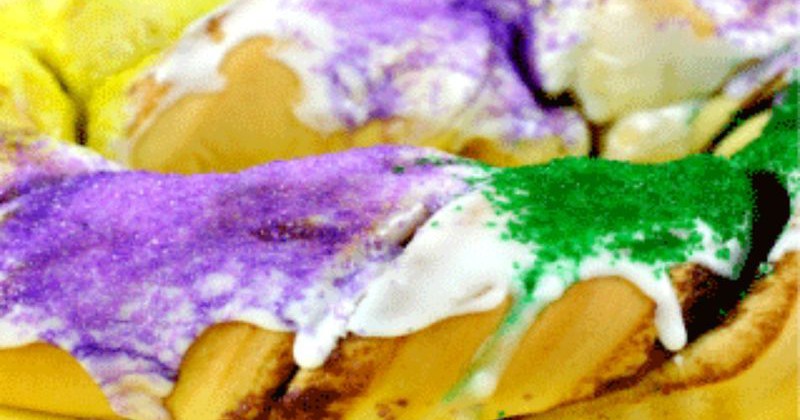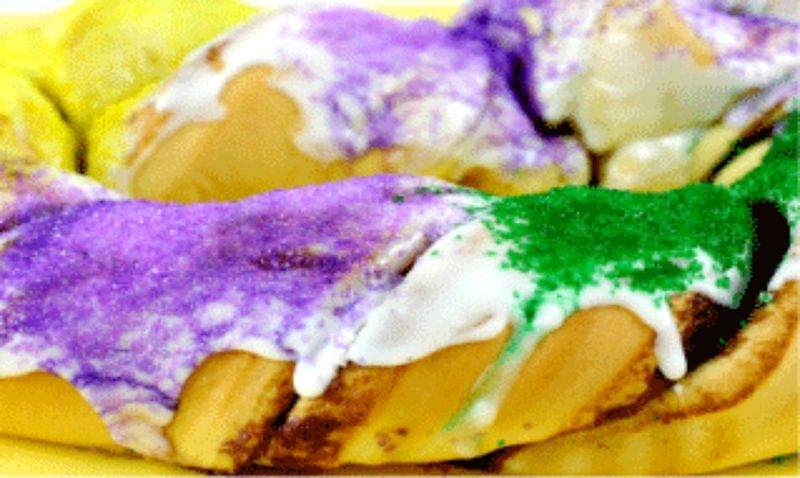King’s Day, King Cakes and the Beginning of Carnival Season
Today marks the Twelfth Night, King’s Day, the Feast of the Epiphany, the day celebrating the Magi’s visit to the Christ Child. In New Orleans, it is the day that opens Carnival season, which culminates with Mardi Gras Day.
I love the idea of liturgical ritual marking the year- after all, these celebrations do have their roots in the Roman Catholic Church calendar, and the Catholic Church is a major formative component of the Creole culture.
During Carnival season, as most of the world has come to know, there’s a whole lot of revelry in New Orleans. There are many fancy balls and parades of every sort. On the evening of Lundi Gras, there is traditionally a house party to attend, and if one still has the energy to get out of bed by the time Mardi Gras morning arrives, there is a breakfast party (perhaps serving grits and grillades and more King cake) before heading out either to Canal Street to view the largest crewes’ parades, to the French Quarter to view the outrageous and raucous, or to Claiborne Avenue in the 7th Ward to watch the Mardi Gras “Indians” dance and party all day and into the night. Colorful beads and festively decorated King cakes, stuffed with little plastic or porcelain babies, abound. The cakes are sent to neighbors, family and friends. They are brought as hostess gifts to the parties. Traditionally, the guest who gets served the slice of cake with the baby in it, must give the next party.
But on Ash Wednesday the partying ends, and the Lenten season of fasting begins, which in turn ends at Easter- the day we celebrate the Resurrection of the Christ. After Easter, modern day New Orleans perks up again with the festival (French Quarter and Jazz and Heritage) season.
While the rest of the world may have forgotten, or is unaware of the liturgical roots, the Creoles of New Orleans, remember them.
My mother told me stories of when she was a young woman, they’d end their all night partying at Mardi Gras balls, by slipping into the back pews at the “fishermen’s” Mass in the wee hours of the morning (still dressed in their party finery) to receive the ashes on their foreheads- a reminder that “from dust you came, and to dust you shall return”.
To this day, New Orleans noticeably changes on Ash Wednesday. Many still attend Church and listen to the priests encourage them to forgo some small pleasure (meat, candy, cake etc.) as a token sacrifice during Lent.
I am thankful for this cycle which reminds us that “to everything, there is a season.” New Orleanians know how to party well, and there is a time for that. We also know that those times must give way to quiet times of sacred reflection.
Nowadays most New Orleanians buy King Cakes from bakeries or groceries- they’re everywhere this time of year. They’re usually made with a rich, sweet bread dough. I’ve started making them here in Los Angeles using a Danish pastry dough- a bit richer, and a little bit more work since the butter is folded in, (and you’ll need a scale which, btw, always yields more accurate measurements) but I think it’s worth it. I am including my recipe for King Cake below. It’s not for the novice baker, but if you love to bake, I hope you’ll set aside a day, and go through the trouble of trying it. I think you’ll be happy.
Laissez le Bon Temps Roulez!
Gisele
King Cake
This recipe makes three @1# loaves. The dough freezes beautifully if well wrapped.
2 cups warm (not hot) water
- 2.5 ounces yeast
- 5 ounces unsalted butter
- 6 ounces sugar
- 2 ounces nonfat dry milk
- 1 teaspoon cardamon or mace
- 1/2 teaspoon salt
- 8 ounces eggs
- 2 ounces egg yolks
- 2.5 pounds all purpose flour
Additional 10 ounces each softened butter and margarine (adding the margarine produces a lighter product which rise more easily, while the butter is added for- what else-flavor) to roll in.
Additional brown and white sugar, cinnamon and pecans for filling the loaves.
Additional egg for egg wash.
1. Pour the water into a bowl and sprinkle the yeast over it to soften.
2. While the yeast is softening combine the sugar, first 5 oz. of butter,dry milk, and spice in the bowl of a stand and mix until combined.
3.Add the eggs and yolks one or two at a time.
4.Add the water and yeast.
5.Add the flour mixing dough until smooth. Then turn to medium speed and mix dough for 3-4 minutes.
6. Pour the dough into an oiled bowl and let it rest in the refrigerator for at least 30 minutes.
7. Dump the dough onto a large floured surface- it takes over my kitchen table- and roll out the dough to a rectangle about 1/2- 3/4 inches thick and about 3 times as long as it is wide.
8. Spread the butter gently over two-thirds of the length of the dough, leaving a 1” margin at the edges.
9. Fold the third of the dough without the butter over the center third, then fold the remaining third on top. This is the first folding. It must be repeated 3 mores time, to get those luscious layers in a Danish dough. Ideally, the dough must rest in the fridge between each rolling and folding process, so that the gluten relaxes enough to roll easily, but I find I can usually do the next one immediately afterwards by rearranging the flour underneath the dough. The rectangle of dough must be turned after each folding so that the long edge is facing you, ensuring that the dough is rolled and stretched out in all directions, not just lengthwise. After each rolling in of the fat, the dough must be rolled out into the rectangular shape again. Be sure to brush off the excess flour after each fold, and make sure you retain the rectangular shapes as best you can.
10. After the 4 rollings in and foldings, place the dough on a parchment covered baking sheet, wrap it very well, and rest it in the fridge for several hours, or overnight.
11. Cut @ 1/3 of rectangular dough for each cake. Roll each piece into a long, thin rectangle @ 8” x 16” and 1/4” thick. Brush the surface with melted butter, and sprinkle with 2 tablespoon of brown sugar, 2 tablespoon white sugar mixed with 1 teaspoon cinnamon, and a handful of toasted and chopped pecans, then roll it into a long thin roll.
12. Flatten the roll slightly with a rolling pin, then make two parallel cuts lengthwise through the dough, cutting through the bottom layer, but leaving about 1 “ uncut at both ends of the roll.
13. Twist the strip, then shape it into a ring and seal the ends together with a tiny bit of egg wash. Then turn the ring over so that the ends are on the bottom.
14. Allow the dough to rise in a warm moist place. I judge its readiness by poking it gently with a floured finger. When the dough retains it indent without bouncing back, I brush it with egg wash, and place it in the oven. Bake it until it is brown all over, and a thermometer stuck into the dough registers 180 degrees.
15. When the dough has cooled decorate it with green, yellow and purple dyed poured fondant, or @ 1- 1/2 cup powdered sugar thinned with a couple of tablespoons of evaporated milk. Decorate with colored caster sugar, sprinkles, dragées, and Mardi Gras beads.











1 Comment
Really like the blog, appreciate the share!
April 25, 2012